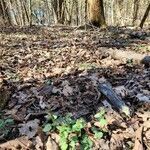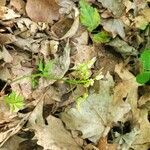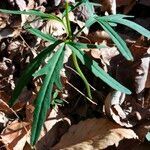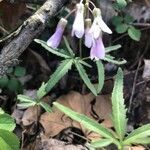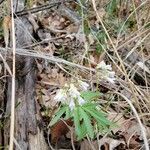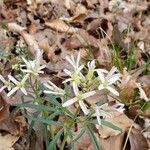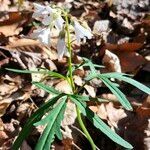Perennials; usually sparsely pubescent, sometimes glabrous. Rhizomes (tuberiform, fragile), moniliform, segments fusiform, 2-10(-20) mm diam. (fleshy). Stems erect, unbranched, (1-)2-4(-5.5) dm, glabrous or pubescent distally. Rhizomal leaves 3-foliolate, (7-) 10-20(-30) cm, leaflets sessile; petiole (4-)7-18(-25) cm; lateral leaflets similar to terminal, blade sometimes smaller; terminal leaflet blade oblong, lanceolate, oblanceolate, or linear, 2.5-6 cm, base cuneate, margins coarsely dentate to incised, laciniate, or 3-lobed (lobes usually toothed to incised, rarely entire, surfaces puberulent or not, trichomes 0.2-0.3 mm). Cauline leaves (2 or) 3, 3-foliolate (usually whorled or opposite, rarely alternate, similar in morphology to rhizomal leaves), petiolate, leaflets petiolulate or subsessile; petiole (1-)1.5-6(-7.5) cm, base not auriculate; lateral leaflets sessile, blade similar to terminal, sometimes smaller; terminal leaflet subsessile or petiolulate (to 3 cm), blade lanceolate, linear, or oblanceolate, (3-)4-10(-12) cm × (3-)5-20 (-25) mm, margins usually coarsely dentate to incised, rarely subentire (margins minutely puberulent). Racemes ebracteate. Fruiting pedicels ascending to divaricate, (6-) 10-27(-33) mm. Flowers: sepals oblong, (4-)5-8 × 2-4 mm, lateral pair slightly saccate basally; petals white to pale pink, oblanceolate, (8-)10-20 × (3-)4-7(-9) mm, (short-clawed, apex rounded); filaments: median pairs 8-12 mm, lateral pair 6-8 mm; anthers oblong-linear, 1.5-2.5 mm. Fruits linear-lanceolate, (2-)2.5-3.8(-4.8) cm × 1.5-3 mm; (valves glabrous or sparsely pubescent); ovules 10-14 per ovary; style (2-)5-9(-12) mm. Seeds brown, oblong, 1.6-3 × 1.8-2 mm. 2n = 128-256.
More
Rhizome constricted at intervals, the segments 2–3 cm; stems 2–4 dm, shortly spreading-hairy above; basal and cauline lvs similar, the former usually absent at anthesis, the latter typically in a whorl of 3 above the middle of the stem, deeply 3-parted or 3-foliolate, the segments linear or lanceolate, subentire to laciniate-toothed, the lateral segments often, the terminal segment sometimes deeply bifid, the whole lf appearing 5-parted; sep 5–8 mm; pet pale lavender, 12–19 mm; frs 2–4 cm; 2n=128, 240, 256. Moist rich woods; Me. and s. Que. to Minn., s. to Fla., La., and Okla. Apr., May, a little earlier than nos. 1 [Cardamine diphylla (Michx.) A. W. Wood] and 5. (Dentaria laciniata) [Cardamine angustata O. E. Schulz] Some possible hybrids with no. 5 have been called Dentaria anomala Eames.
A cabbage family herb. The stems are erect and 20-40 cm tall. It has a long rhizome with fleshy segments.
